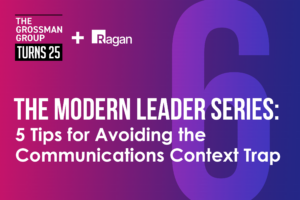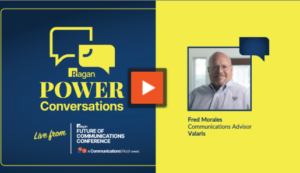Why corporate communicators should abandon PowerPoint – and how to do it
It’s time to scrap the one-way, top-down presentation tools of yore. Try these tips to craft more interactive meetings, speeches and gatherings.

Editor’s note: We are re-running the top stories of 2021 as part of our year-end countdown.
Digital communication tools have become the superheroes of today’s remote workplace.
Without Zoom, Microsoft Teams and other digital systems, collaboration among remote workers, employers, agencies and clients today would be nearly impossible. However, if you’re a corporate communicator who’s facing time-sensitive productivity issues (and who isn’t?), there’s one digital tool you should ditch: PowerPoint.
To be fair, PowerPoint and its cousin Keynote allow us to whip up visually stunning decks so we can talk at large audiences. But if your goal is to conduct meetings in a culture of collaboration and make decisions during those meetings, spark team creativity or engage your audience, then you need to think beyond PowerPoint – especially during our remote-working, semi-quarantined way of life.
PowerPoint’s weakness
One-way communication is fading fast for the same reasons that mass communication and advertising are no longer seen as the best ways to reach target audiences. Furthermore, one-way communication doesn’t follow younger generations’ expectations to participate in dialogue that’s rooted in transparency, authenticity and reality – that’s where PowerPoint fails us.
PowerPoint’s limitations are not just the labor it takes to craft the perfect story, but also in its inability to be inclusive and invite conversation. It’s best used as a tool to “present” rather than a means to incite dialogue about key issues, encourage others to join in or create alignment within large groups of people. The program often encourages those on the receiving end to conduct internal dialogue (inside their own heads) as they translate the content they’re experiencing, or mentally craft responses – often while subconsciously summarizing key ideas. Other times, the audience simply selectively listens to the content while they surf their email, social media, the news or even daydream out the window.
A number of studies show that PowerPoint is not only a poor communications tool, it can actually inhibit certain business outcomes. Forbes and other business publications have reported on a Harvard study, for example, which discovered that presenters using “zoomable user interfaces” (think Prezi), are viewed as more “knowledgeable and professional than PowerPoint users.” In fact, PowerPoint was rated by the online study participants as “no better than verbal presentations with no visual aids.”
The bottom line, to quote Geoffrey James, who wrote last year in Inc., is that, “… all the time and effort you spend creating a fancy PowerPoint is at best wasted and at worst counterproductive.
What are the alternatives?
By removing PowerPoint from your meetings, you’ll empower your teams to work through problems together using collaborative dialogue and constructive disagreement. But how do we break free from our collective PowerPoint addiction?
Fortunately, many “old-school” work session techniques, which we used when we could all safely gather around a conference table, are still viable in our virtual world. At our brand design agency CBX, we draw out people’s best thinking with the same work session techniques today that we did pre-pandemic, including:
Mission clarity and definition. Spending a half day to truly understand the goals, objectives and ultimate deliverables can save time, energy and re-work in the future. Working and aligning as a cross-functional team from the beginning can make a big difference to ensure everyone’s perspective is heard and the whole team is marching forward in unison.
To achieve mission clarity and definition during virtual meetings, it’s more important than ever to prepare for meetings, run a tight agenda, appoint an individual to run the meeting, and create clear objectives and desired outcomes. The team must be clear upfront what is expected of them during the meeting – What decisions will we make? Are we gathered for alignment to create a go-forward plan? Do we have clear next steps and responsibilities?
Fist of five. Using alignment techniques like fist of five prior at the close of any meeting allows all attendees to have a voice, share a concern or give feedback in real-time, resulting in open, direct conversations and preventing the dreaded “meeting after the meeting.”
How it works: Each person votes for their preference, showing five fingers if they’re 100% on board with a decision or idea; four fingers if they think pros outweigh cons; three fingers mean they’ve some reservations, but believe it’s the best decision/idea on the table; two fingers mean, “I’m not buying it;” and one finger stands for, “I’m going to walk out the door – you’re all crazy.” Anyone voting with one or two fingers has two minutes to state their POV and then the team is given two minutes to change their minds. The process continues until everyone’s in agreement.
How to adapt fist of five for virtual meetings: With white boards and flipcharts a thing of in-person meetings, products like Miro and Mural substitute well as virtual space where teams collaborate across time zones and locations. These tools allow for virtual voting, 24/7 input and feedback opportunities, real-time collaboration to work cross-office/cross-country in a moment’s notice.
At CBX, we’re currently using Miro for all design work-in-progress collaborations across departments, allowing people to give feedback before, during and after meetings. We also leverage joint client-agency work sessions and virtual white boards to collect and share research, insights, competitive and category findings to create and collaborate on strategic direction, design strategy or positioning.
Time-boxing. CBX uses time-box techniques during meetings and work sessions to achieve results quickly. When individuals are given a focused task and limited time, they come to a recommendation and rationale more quickly and often, and with greater clarity.
How it works: Once team discussions conclude, everyone has, for example, 30 minutes to leave the meeting and “accomplish their area of expertise’s task at hand.” The team reassembles after a half-hour to share their thinking, offer recommendations and make a decision.
How to adapt time-boxing for virtual meetings: Because teams need to carve out thinking time from their schedules to make time-boxing work, make sure that each team members’ calendar isn’t filled with status meetings, work-in-progress meetings or other stakeholder informational meetings. These types of meetings, while necessary, are better achieved in a 15-minute “stand-up” format where updates are shared and co-dependencies for progress are identified.
Crucial success factors
As easy as it is to criticize PowerPoint for its limitations, we all know it’s not that easy to abandon a legacy with which we’re all comfortable. Any effort to replace PowerPoint with other tools and techniques needs acceptance from the top down, as well as open minds and willingness to work collaboratively among all participants
Lastly, for PowerPoint alternatives to work, there has to be an acknowledgement and acceptance that alignment techniques flatten an organization’s hierarchy because everyone has a voice. If a team or organization struggles with this concept, you need to take baby steps. However, from our experience, once those sitting on the fence see the power of an alternative approach, they will agree that it’s more engaging, that their voice is being heard and that they are part of the process, not just passively receiving information – resulting in more engaged and productive team members.
Stacy Hintermeister is VP of marketing and growth at brand design firm CBX, based in New York City and Minneapolis. Learn more at https://cbx.com.
Learn how to craft powerful presentations and connect with executive comms leaders at our upcoming Speechwriters and Public Affairs Virtual Conference on March 4.







LOVED this article… I was hoping for an insight on MURAL. I have begun to use this as I own a business but also teach graduate business courses…I am trying to use less ppt! Especially since my courses meet for 4 hours per session. I use “stand-up meetings” and your Fist of Five is awesome. Time Box is terrific too.. Thank you!
When I saw the title for the article I was intrigued but upon reading it I was disappointed. The article’s focus was on how the author’s firm runs collaborative design sessions. That in itself is fine but when you have 30 minutes to present your program for funding and approval you are not going to dive into mission clarity exercises and ask the SVP to respond with fingers in the air. Powerpoint has its limitations and most people (including myself) hate it but I have not found a better way to efficiently present a situation and drive to decision in a single (<1 hour) meeting.
If the title was around why Powerpoint should be abandoned for design exercises then the context would have been clear.
I have found that in meetings many people miss what a whiteboard offered– a way to roughly write down ideas and thoughts in a non-linear fashion. I’ve begun with my team in less formal presentations or in brainstorming sessions to use a document camera instead, pointed at blank paper so that I can write what people are contributing as they share– over zoom it basically looks like a whiteboard. I also like Mural, though sometimes I think we all get tired of typing our ideas instead of writing. I agree though with the comment that in more formal presentations I am not sure how we cannot use PowerPoint…
I create and run many presentations, whether in person or webinar. I’ve been a huge fan of interactive education my whole life. Why? It works. Participants are encouraged to answer questions, eg. “Why should I hire you?” “What makes you special or unique?’ When it’s an in-person presentation, the facilitator then engages with the attendees to expand on the answers and get the energy moving in the room. I walk up and down the room and literally get people involved.
The “chat” feature on Zoom enables me to encourage participants to login. True, “engagement” may be lower. On the other hand, I’ve also seen a burst of activity as the answers start coming in. I read out the answers and acknowledge the contributors. Others then get inspired (and less anxious) and the process takes on renewed strength. It’s fun too!
Like any kind of presentation, it’s always important to know your audience, your style and what will bring out the best participation.